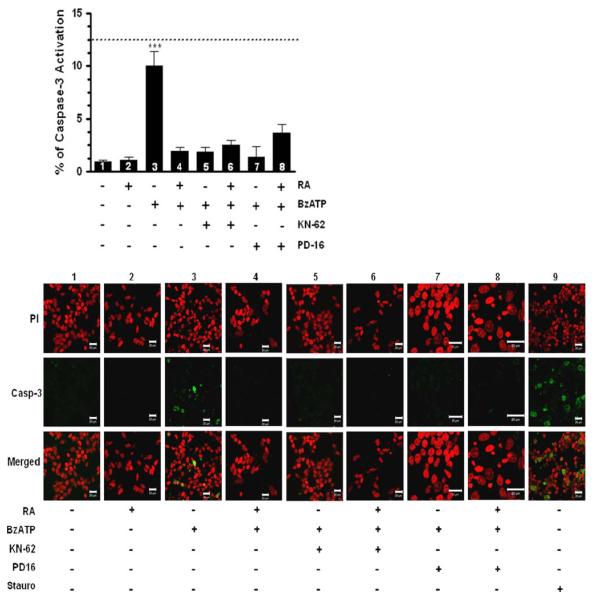Fig. 8.
RA treatment (differentiating conditions) abolishes caspase-3 activation in human SH-SY5Y neuroblastoma cells. Human SH-SY5Y neuroblastoma cells were grown to 80% confluency onto poly d-lysine-coated glass dishes in normal serum. Then, cells were subjected to medium replacement containing low serum and supplemented with 15 μM RA as described in “Materials and methods” section. Chronic RA treatment was performed by replacing the medium with fresh medium supplemented with 15 μM RA every 2 days. On the experimental day 5, cells were pretreated with 0.5 μM KN-62 for 20 min followed by 300 μM BzATP for 48 h. Also, some cultures were pretreated with 10 μM PD169316 (PD16) for 10 min followed by 300 μM BzATP for 48 h. After treatments, confocal immunofluorescence microscopy assays were performed as described in “Materials and methods” section. Non-RA treated cells (undifferentiated cells) and RA-treated cells (differentiated cells) without additional treatments served as controls. Dashed line represents cultured cells treated with 4 μM staurosporine for 2 h as positive control (n = 15; 12.4 ± 1.4). All counts were performed using a range of 53–1882 cells from different fields. Data are the means ± SEM of values from at least three independent experiments. BzATP- and KN-62-treated cells were compared to non-RA treated cells (undifferentiated cells) and RA-treated cells (differentiated cells) without additional treatments (*** P < 0.001 one-way ANOVA). Representative images are shown, scale bar = 20 μm. (PI: propidium iodide; Casp-3: cleaved-caspase-3)

